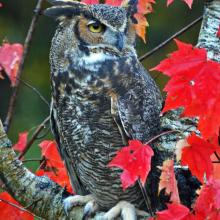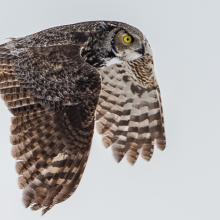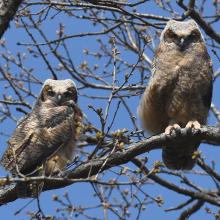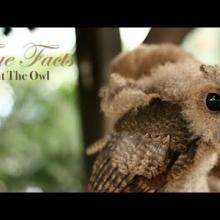

Join BirdNote tomorrow, November 30th!
Illustrator David Sibley and actor H. Jon Benjamin will face off in the bird illustration battle of the century during BirdNote's Year-end Celebration and Auction!
High in a leafless cottonwood, a female Great Horned Owl incubates two eggs. As light snow falls on her back, her mate roosts nearby. Since December, this pair has been hooting back and forth regularly at night. Great Horned Owls nest in winter, because the owlets, which hatch after a month of incubation, must remain near their parents a long time compared to many other birds — right through summer and into early fall.
BirdNote®
Great Horned Owls Nest in Winter
Written by Bob Sundstrom
This is BirdNote!
[Great Horned Owl hooting]
On a chilly day, mid-winter, you notice a large nest made of sticks high in a leafless cottonwood. Atop the nest sits a large, dark shape, its broad head sporting two ear-like tufts, suggesting a cat’s ears. A female Great Horned Owl is incubating two eggs. A light snow falls on her back, as her mate roosts unseen in a nearby conifer. Since December, this pair has been hooting back and forth regularly at night. [Great Horned Owl pair hooting + winter wind]
Why risk the year’s most severe weather by nesting now? Probably because Great Horned owlets, which hatch after a month of incubation, must remain near their parents a long time compared to many other birds — right through summer and into early fall. During this time, young owls learn the skills they need to hunt on their own — before the rigors of the next winter set in.
This adaptive strategy has proven very successful: Great Horned Owls are the supreme predatory night birds from the northernmost forests of Canada to Tierra del Fuego. [Great Horned Owl pair hooting]
We have a photo of that owl, covered in snow, on our Facebook page. [pause] Have a look.
For BirdNote, I’m Mary McCann.
For BirdNote, I’m Mary McCann.
###
Bird sounds provided by The Macaulay Library of Natural Sounds at the Cornell Lab of Ornithology, Ithaca, New York. Single Great Horned Owl recorded by W.L. Hershberger; pair, by W.R. Fish.
Winter wind Nature SFX Essentials #2 recorded by Gordon Hempton of Quiet.Planet.com.
BirdNote’s theme music was composed and played by Nancy Rumbel and John Kessler.
Producer: John Kessler
Executive Producer: Chris Peterson
© 2016 Tune In to Nature.org January 2014/2018/2020/2022 Narrator: Mary McCann
ID#012506GHOWGHOW-03b










